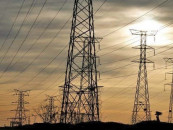NDC - Pakistan and missing links
Country has made voluntary commitment to halve projected emissions by 2030

Pakistan has just completed work on Nationally Determined Contribution (NDC) and submitted it to the United Nations Framework Convention on Climate Change (UNFCCC).
The document has seemingly done an excellent job to highlight the efforts of Pakistan aimed at tackling climate change.
However, the analysis of NDC shows that mitigation is priority sector for action. Pakistan has made voluntary commitment to halve the projected emissions by 2030. The country has planned to voluntary reduce 15% emission while the remaining 35% will be met by through assistance from the world. Pakistan has also offered to shift 30% of its transportation to electric modes.
NDC also emphasised that till 2030, 60% energy should be generated from renewable sources including hydropower, solar, wind and biogas to meet the target of 50% reduction in greenhouse gas emissions.
The nation will need $101 billion till 2030 and an additional $65 billion till 2040 to achieve the committed targets and goals. This amount is needed to achieve the energy targets and it does not include the cost of reduction of greenhouse gas (GHG) emissions from agriculture and other sectors.
The voluntarily commitments made by Pakistan in NDC has raised many questions and it is hoped that the government has the answers.
Firstly, there is a need to know how Pakistan will generate the required resources. By looking at the economic health of the nation, it does not seem possible for it to generate huge amounts of financial resources. If we follow the formula of voluntary and conditional GHG emissions, Pakistan has to raise at least $15 billion till 2030 to meet its commitments.
In addition to that, the nation will also require financial resources for adaptation. A needs study suggested that by 2030, Islamabad would need $11.2 billion on annual basis for the adaptation.
The second query is what Pakistan would do with the existing capacity of electricity production. It is an open secret that Pakistan has agreements with independent power producers (IPPs), and these deals bind the country to buy power from them. In addition, the nation has to purchase power according to their capacity and they are not concerned with whether Pakistan uses it or not. Pakistan is already facing a daunting problem of circular debt due to these binding deals.
Now, a question arises regarding how Pakistan will negotiate and convince IPPs. If the country continues to fulfill commitments without negotiating with the power producers, it will create a two faceted problem. On one hand, it will accelerate the circular debt while on the other, the country will be left with surplus energy. By looking at the facts, it can be assumed that it will be difficult for Pakistan to go for such random shift.
The third question is will the ground realities allow Pakistan to reduce 50% or even 15% of emissions.
The government claims that it had calculated GHG emissions on the basis of growth rate of 9% or above. However, the data analysis depicts that it would be extremely difficult, if not impossible, to achieve the target of GHG emissions. The country is experiencing tough times and the government needs to revive the economy and put it on the track of rapid growth and development.
Islamabad needs to invest in production, which is direly needed to tackle the economic crisis. Besides, the China-Pakistan Economic Corridor (CPEC) has entered its second phase which focuses on industrialisation and agricultural cooperation. Pakistan and China are working to uplift and boost investment in the industrial sector.
The work on establishment of Special Economic Zones has been expedited to achieve the goal of industrialisation. Agriculture cooperation will enhance crop production and expand cultivation to meet future demands.
Three solutions
In this context, the industrial and agriculture growth will increase GHG emissions. So, there is a need to ask how Pakistan would meet its commitments under the NDC. Now, there are three options. First, Pakistan should only allow green and climate compatible industrial and agricultural investment. Secondly, the country must bring down its goals of industrial and agricultural growth. Thirdly, it should make efforts to create balance by rethinking its commitments for GHG emissions and growth in the long run.
Adaptation is another area, which is part of the NDC. Government claimed that it would prepare its first national adaptation plan by 2023. It is a matter of grave concern that a country which is highly vulnerable to climate change does not have an adaptation plan.
Although, adaptation must be prime focus of the country, however it stands without a plan leave alone comprehensive actions. We can only find sporadic efforts, here and there. Agriculture sector is suffering the most and it requires urgent assistance to cope with the challenges posed by climate change. A program for climate smart agriculture, which was announced in 2019, is still in its planning phase. Pakistan also needs urgent schemes to check seawater intrusion. Although, government is working on mangroves but there is need to do more.
On the basis of the above discussion, it can be suggested that Pakistan should rationalise its commitments. They must be in line with the development status and needs of the country and should not be made to please the donors or the international community. Thus, Pakistan should relook at the policy and strategy to opt for GHG reduction commitment. Pakistan can adopt a different strategy or policy.
The country can avoid an absolute number such as 50% and commit in terms of efficiency and intensity of carbon emission. It can pledge to reduce GHG emission on per capita GDP basis during the due course of time. For example, China vowed to lower carbon intensity by 18% in its 14th Five Year Development Plan. The energy intensity will also be brought down by 13.5% by 2025.
In the conclusion, Pakistan must focus more on the adaptation. The nation needs to secure funding from all sources, domestic and international. Failure to prioritise adaptation will have grave implications for Pakistan because agriculture and food security will bear the brunt. Food insecurity is already high and according to different studies, 58.8% of the population is food insecure. Climate change will further complicate the situation if Pakistan failed to prioritise the adaptation.
The writer is a political economist
Published in The Express Tribune, November 1st, 2021.
Like Business on Facebook, follow @TribuneBiz on Twitter to stay informed and join in the conversation.



















COMMENTS
Comments are moderated and generally will be posted if they are on-topic and not abusive.
For more information, please see our Comments FAQ